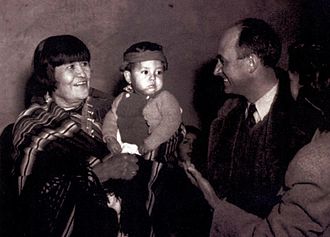Maria Martinez, San Ildefonso Pueblo Potter
+ Add Artist to My Preferences

Maria Martinez of San Ildefonso Pueblo is probably the most famous of all pueblo potters. She and her husband, Julian, discovered in 1918 how to produce the now-famous black-on-black pottery and they spent the remainder of their careers perfecting and producing it for museums and collectors worldwide.
Updated Information: Noted authority Richard Spivey sent me the following comment which we are pleased to print: "Maria retired from pottery making in October 1970; she made no pottery for the commercial market after that time. Santana did not pick up on painting Maria's pottery after Po's death since Maria was no longer potting."
All Image Sources:
- Maria Plate (right): Adobe Gallery
- Below of Maria Martinez, shown with physicist Enrico Fermi, circa 1948: Wikipedia
TAGS: Pueblo Pottery, San Ildefonso Pueblo, Popovi Da, Santana and Adam Martinez, Julian Martinez
Maria Montoya Poveka Martinez (1887-1980) Pond Lily Signature As It Evolved Over Time. Note that early works by Maria and Julian are unsigned (1918-1923).
.gif)
By 1923, Maria began signing Marie on pieces made by her and Julian. His name was omitted because making pottery was "woman's work." Pottery made by Maria and painted by Julian, signed Marie, was most probably made between 1920 and 1925.
.gif)
Pottery made by Maria and painted by Julian between 1925 and 1943 bears the dual signature Marie + Julian. By 1925, and until his death in 1943, Maria shared the signature with Julian.
.gif)
Following the death of Julian, their son Adam and his wife Santana helped Maria with the design and firing of her pottery. Pieces made between 1943 and 1954 are signed Marie + Santana.
.gif)
When Maria began signing pottery, she was told, probably by Chapman, that "Marie" was a more familiar name than "Maria" to the non-Indian public. She therefore signed the name "Marie" for about 30 years. Following the publication of Alice Marriott's book, Maria: The Potter of San Ildefonso, she began signing her true name, "Maria."
.gif)

Around the mid-1950s, Popovi Da began working with his mother, helping her with designing and firing her pottery. They began to co-sign pieces and Popovi started putting a date on each piece, probably around 1959.
.gif)
Maria often made small pieces of pottery without the assistance of her husband, her son, or her daughter-in-law. These are always plain, polished, undecorated pieces and are usually quite spectacular and affordable. They are signed Maria Poveka. The signature Maria Poveka on undecorated blackware, according to Richard Spivey, was a signature started in 1956 and abandoned in the mid-1960s, so it lasted only a decade. However, in 1959, Popovi Da started adding a date to the pottery signatures, even those signed Maria Poveka. That fact would shorten the date of undated Maria Poveka pottery to the 1956-1959 dates.
Recommended Reading:
- The Living Tradition of Maria Martinez by Susan Peterson. 1977. Kodansha International, New York.
- Fourteen Families in Pueblo Pottery by Rick Dillingham. 1994. University of New Mexico Press, Albuquerque.
- Maria by Richard L. Spivey. 1979, second printing 1981. Northland Publishing.
- The Legacy of Maria Poveka Martinez by Richard L. Spivey. 2003. Museum of New Mexico Press.
- Maria, The Potter of San Ildefonso by Alice Marriott. 1948. First edition. University of Oklahoma Press.

